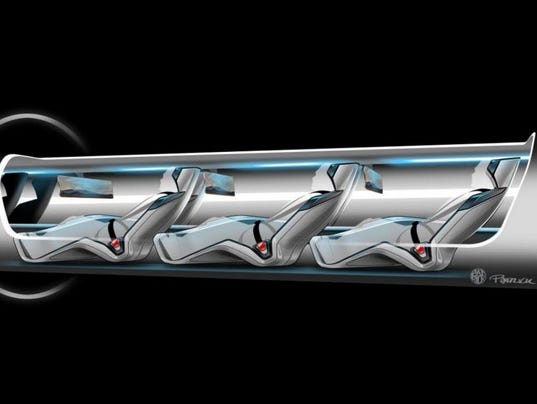
SAN FRANCISCO – The hyperloop wars are on.
On Monday, a crowdsourced enterprise led by NASA and Boeing veterans called Hyperloop Transportation Technologies announced that it had licensed passive magnetic levitation technology to power its prototype system, which like other hyperloop templates promises to shuttle humans and goods in a vacuum tube system at speeds up to 750 mph.
How fast is that? Zipping from Los Angeles to San Francisco would take 30 minutes as compared to a six-hour drive or an all-day train ride.
"Utilizing a passive levitation system will eliminate the need for power stations along the Hyperloop track, which makes this system the most suitable for the application and will keep construction costs low," Bibop Gresta, chief operating officer of Hyperloop Transportation Technologies, said in a press release.
"From a safety aspect, the system has huge advantages, levitation occurs purely through movement, therefore if any type of power failure occurs, Hyperloop pods would continue to levitate and only after reaching minimal speeds touch the ground," he said.
The announcement comes just two days before rival Hyperloop Technologies Inc. plans to showcase the evolution of its technology to investors and media in the desert north of Las Vegas. On its website, Hyperloop Technologies features photos and videos showing off large tubes that would house long pods for either people or cargo. Both HTI and HTT are based in Los Angeles.
Another player in the space is skyTran, located at NASA Research Park just south of San Francisco. The company recently unveiled a technology demonstration system showcasing how its two- and four-person vehicles will work, and are aiming to build a 30-mile track in Lagos, Nigeria. skyTran has raised $30 million and is operating in partnership with NASA.
The promise of hyperloop offers the possibility of moving people and things at great speeds without using fossil fuels. The pitfalls include making such transportation reliable while mitigating for potential catastrophes unfolding at around the speed of sound.
Also in the hyperloop race is SpaceX, the rocket company founded by Tesla CEO Elon Musk, who first popularized the idea of shuttling people and cargo in tubes back in 2013.
In January, a team from MIT won an inaugural hyperloop competition sponsored by SpaceX. Similar to HTT's approach, the MIT team proposed placing magnets on the pods that react to passive coils in the tubes, thereby generating lift or levitation.
 Hyperloop Transportation Technologies has announced that is licensing tech that would allow high-speed transportation at lower than anticipated costs when compared to existing magnetic transportation tech. (Photo: Hyperloop Transportation Technologies)
Hyperloop Transportation Technologies has announced that is licensing tech that would allow high-speed transportation at lower than anticipated costs when compared to existing magnetic transportation tech. (Photo: Hyperloop Transportation Technologies)
“The beauty of the system we designed is that it’s completely passive, an elegant property that will make our pod very scalable," team captain Philippe Kirschen, a master’s student in aeronautics and astronautics, told MIT News when the team won.
Musk has tweeted that SpaceX may build a test track for its emerging hyperloop tech, "most likely in Texas."
While SpaceX is backed by Musk's drive and billions and skyTran has government support, the other two entrants in the hyperloop sweepstakes - HTT and HTI - have taken radically different approaches to financing their efforts.
Hyperloop Transportation Technologies is powered by financial donations and the know-how of space tech veterans donating their time to the project. In contrast, Hyperloop Technologies Inc. has raised $37 million to date, and is co-founded by early Uber investor Shervin Pishevar and former SpaceX engineer Brogan BamBrogan.
HTT's passive magnetic levitation approach is based on science developed by the late physicist Richard Post of Lawrence Livermore National Laboratory, east of San Francisco.
By placing magnets on the hyperloop transportation pods and having them react - and cause lift - with coils in the transportation pods, one can avoid the costly approach currently used by magnetic levitations, or maglev, high-speed trains currently in use in Europe and China. Those systems require pricey tracks laced with copper coils.
In 2015, HTT said it would be installing its hyperloop tech in a proposed 75,000-resident solar-powered city in Quay Valley, Calif., halfway between Los Angeles and San Francisco. In February, HTT CEO Dirk Ahlborn announced that it was in talks with the Slovakian government about possibly building a hyperloop route in the former Eastern Bloc nation.


